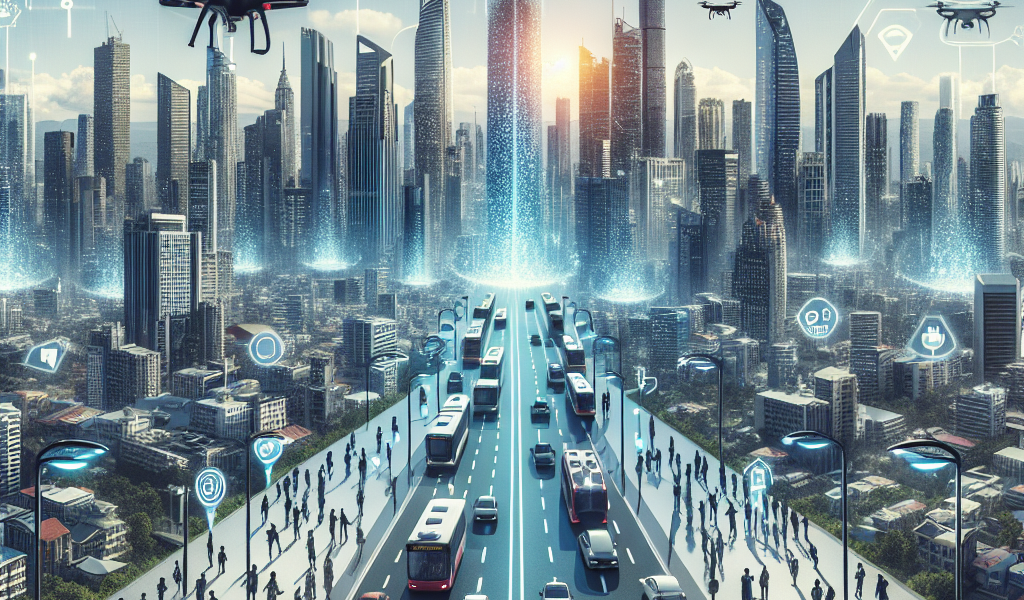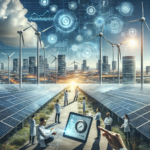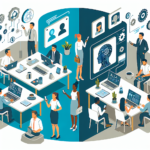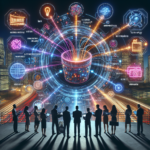-
Table of Contents
“Transforming Urban Living: IoT Paving the Way for Smarter Cities”
Introduction
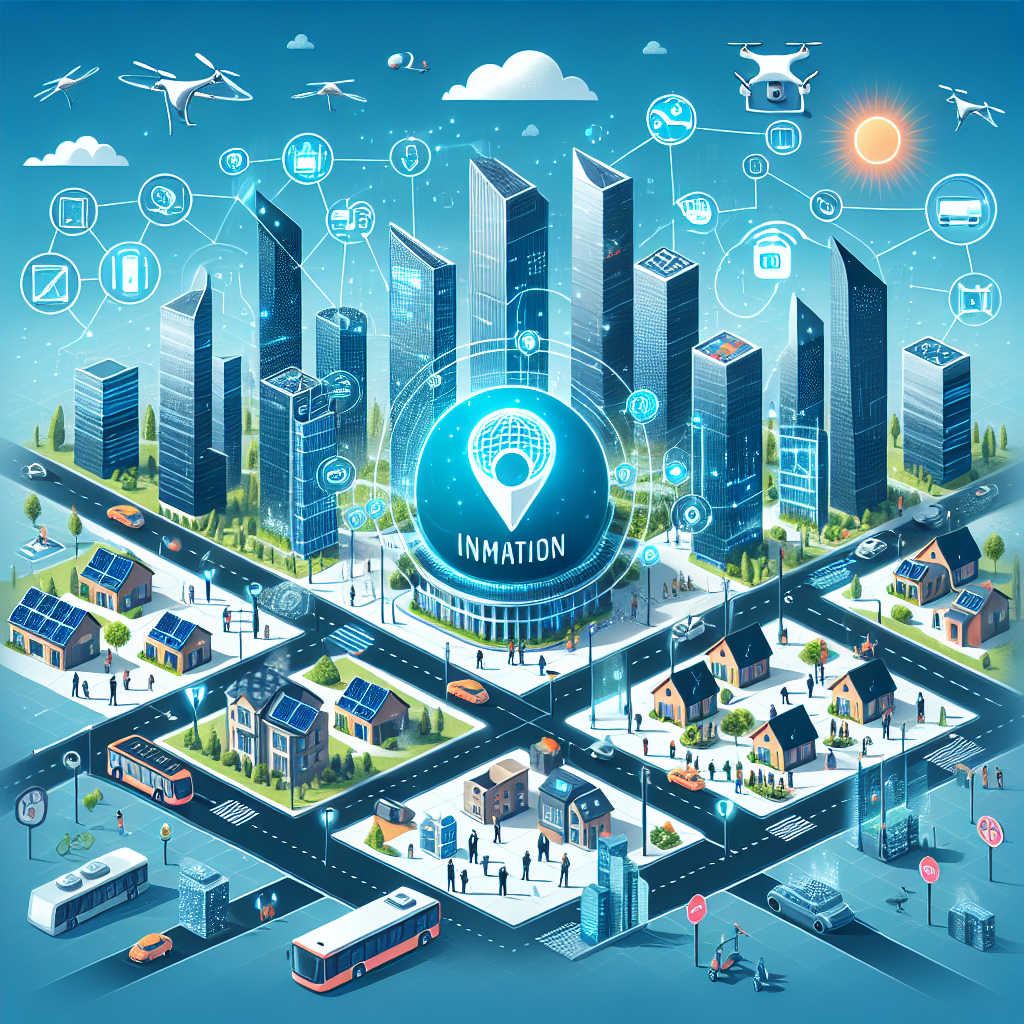
The Internet of Things (IoT) is revolutionizing urban living by creating smarter cities that are more efficient, sustainable, and livable. By interconnecting devices, sensors, and systems, IoT enables real-time data collection and analysis, leading to improved decision-making and resource management. Smart cities leverage IoT technology to enhance various aspects of urban life, including transportation, energy management, public safety, and environmental monitoring. For instance, smart traffic systems reduce congestion and emissions, while intelligent energy grids optimize power distribution and consumption. Additionally, IoT-driven public safety initiatives, such as connected surveillance and emergency response systems, enhance security and resilience. As cities continue to grow, the integration of IoT solutions is essential for addressing the challenges of urbanization and fostering sustainable development.
Enhancing Urban Mobility Through IoT-Enabled Smart Transportation Systems
In the bustling heart of modern cities, the Internet of Things (IoT) is revolutionizing urban mobility, transforming how people navigate their daily commutes. As urban populations swell, the need for efficient, sustainable, and intelligent transportation systems becomes increasingly critical. IoT-enabled smart transportation systems are stepping up to meet this challenge, offering innovative solutions that enhance the efficiency and convenience of urban travel.
One of the most significant impacts of IoT on urban mobility is the optimization of traffic flow. By integrating IoT sensors and devices into traffic management systems, cities can collect real-time data on vehicle movement, congestion levels, and road conditions. This data is then analyzed to adjust traffic signals dynamically, reducing bottlenecks and improving the overall flow of traffic. For instance, smart traffic lights can change their timing based on current traffic conditions, allowing for smoother transitions and reducing wait times at intersections. Consequently, this leads to shorter commutes, lower fuel consumption, and decreased emissions, contributing to a cleaner and more sustainable urban environment.
Moreover, IoT is enhancing public transportation systems, making them more reliable and user-friendly. Real-time tracking of buses, trains, and trams allows commuters to access up-to-the-minute information on arrival times and delays through mobile apps and digital displays at stations. This level of transparency not only improves the passenger experience but also encourages more people to opt for public transport over private vehicles, alleviating traffic congestion and reducing the city’s carbon footprint. Additionally, IoT-enabled predictive maintenance systems monitor the health of public transport vehicles, identifying potential issues before they lead to breakdowns, thus ensuring a more reliable service.
In addition to public transportation, IoT is also transforming the way we approach shared mobility services. Ride-sharing platforms, bike-sharing programs, and electric scooter rentals are all benefiting from IoT technology. For example, IoT devices embedded in shared vehicles provide real-time data on their location, availability, and battery status. This information is crucial for both users and service providers, as it allows for efficient fleet management and ensures that vehicles are readily available when and where they are needed. Furthermore, IoT can facilitate seamless payment systems, enabling users to pay for their rides through mobile apps, making the entire process more convenient and user-friendly.
Parking, a perennial urban headache, is also being addressed through IoT solutions. Smart parking systems use sensors to detect available parking spaces and relay this information to drivers via mobile apps or digital signage. This reduces the time spent searching for a spot, decreases traffic congestion caused by circling vehicles, and lowers emissions from idling engines. Some advanced systems even allow for automated payment and reservation of parking spaces, streamlining the process further.
As cities continue to grow and evolve, the integration of IoT in transportation systems will play a pivotal role in shaping the future of urban mobility. By leveraging real-time data and advanced analytics, IoT-enabled smart transportation systems are making cities more efficient, sustainable, and livable. The journey towards smarter cities is well underway, and IoT is at the forefront, driving innovation and improving the quality of life for urban dwellers. As we look to the future, the potential for IoT to further enhance urban mobility is boundless, promising a smarter, more connected world.
Improving Public Safety with IoT-Driven Surveillance and Emergency Response
In the rapidly evolving landscape of urban development, the Internet of Things (IoT) is playing a pivotal role in transforming cities into smarter, more efficient, and safer environments. One of the most significant areas where IoT is making a profound impact is in public safety. By leveraging IoT-driven surveillance and emergency response systems, cities are becoming better equipped to protect their residents and respond to crises more effectively.
To begin with, IoT-enabled surveillance systems are revolutionizing the way cities monitor and manage public spaces. Traditional surveillance cameras, while useful, often require manual monitoring and are limited in their ability to provide real-time data. In contrast, IoT-driven cameras and sensors can continuously collect and analyze data, providing city officials with instant insights. For instance, smart cameras equipped with artificial intelligence can detect unusual activities, such as unattended bags or loitering in restricted areas, and immediately alert authorities. This proactive approach not only enhances security but also allows for quicker intervention, potentially preventing incidents before they escalate.
Moreover, IoT technology extends beyond visual surveillance. Environmental sensors can monitor air quality, noise levels, and even detect hazardous materials. In the event of a gas leak or chemical spill, these sensors can trigger automatic alerts to emergency services, ensuring a swift response. This integration of IoT into environmental monitoring is particularly crucial in densely populated urban areas, where the potential for harm is significantly higher.
Transitioning to emergency response, IoT is equally transformative. One of the most critical aspects of effective emergency management is communication. IoT devices can facilitate seamless communication between various emergency services, such as police, fire departments, and medical teams. For example, during a natural disaster, IoT-enabled devices can provide real-time updates on the situation, helping coordinate rescue efforts and allocate resources more efficiently. Additionally, smart traffic management systems can adjust traffic signals to create clear paths for emergency vehicles, reducing response times and potentially saving lives.
Furthermore, IoT technology can enhance the capabilities of first responders. Wearable devices, such as smart helmets and vests, can monitor the health and safety of firefighters and paramedics in real-time. These devices can track vital signs, detect exposure to harmful substances, and even provide navigation assistance in smoke-filled or structurally compromised environments. By ensuring that first responders are well-equipped and informed, IoT contributes to more effective and safer emergency interventions.
Another noteworthy application of IoT in public safety is in the realm of predictive analytics. By analyzing data from various sources, such as crime reports, social media, and IoT sensors, cities can identify patterns and predict potential threats. For instance, if data indicates a spike in criminal activity in a particular area, law enforcement can increase patrols and take preventive measures. This data-driven approach not only helps in addressing current issues but also in mitigating future risks.
In conclusion, the integration of IoT into public safety infrastructure is a game-changer for modern cities. By enhancing surveillance capabilities, improving emergency response coordination, and leveraging predictive analytics, IoT is helping create safer urban environments. As technology continues to advance, the potential for IoT to further revolutionize public safety is immense. Cities that embrace these innovations are not only investing in the well-being of their residents but also paving the way for a smarter, more secure future.
Optimizing Energy Consumption in Smart Cities Using IoT Technology
In the quest to create smarter cities, the Internet of Things (IoT) is playing a pivotal role in optimizing energy consumption. As urban areas continue to expand, the demand for energy-efficient solutions has never been more critical. IoT technology, with its ability to connect and communicate vast networks of devices, offers innovative ways to manage and reduce energy usage, thereby contributing to more sustainable urban living.
One of the most significant ways IoT is transforming energy consumption in smart cities is through smart grids. These advanced electrical grids use IoT sensors and devices to monitor and manage the distribution of electricity in real-time. By collecting data on energy usage patterns, smart grids can predict demand and adjust the supply accordingly, reducing waste and ensuring that energy is used more efficiently. This not only helps in lowering energy costs but also minimizes the environmental impact of energy production.
Moreover, IoT-enabled smart meters are revolutionizing how consumers interact with their energy usage. These devices provide real-time feedback on energy consumption, allowing residents and businesses to make informed decisions about their energy use. For instance, smart meters can alert users when they are consuming more energy than usual, prompting them to take corrective actions such as turning off unnecessary lights or adjusting their heating and cooling systems. This level of awareness and control can lead to significant reductions in energy consumption and costs.
In addition to smart grids and meters, IoT technology is also enhancing the efficiency of public infrastructure. Street lighting, for example, is a major energy consumer in cities. Traditional streetlights often remain on throughout the night, regardless of whether they are needed. However, IoT-enabled smart streetlights can adjust their brightness based on real-time data from motion sensors and ambient light detectors. This means that streetlights can dim or brighten as needed, conserving energy without compromising public safety.
Furthermore, IoT is making buildings smarter and more energy-efficient. Smart building systems use IoT sensors to monitor various parameters such as temperature, humidity, and occupancy. By analyzing this data, these systems can optimize heating, ventilation, and air conditioning (HVAC) operations to ensure that energy is used only when and where it is needed. For example, if a room is unoccupied, the system can automatically adjust the temperature to save energy. This not only enhances comfort for occupants but also significantly reduces energy consumption.
Transportation is another area where IoT is making a substantial impact on energy optimization in smart cities. Connected vehicles and smart traffic management systems use IoT technology to reduce congestion and improve fuel efficiency. By analyzing traffic patterns and providing real-time updates to drivers, these systems can help reduce idle times and optimize routes, leading to lower fuel consumption and emissions. Additionally, IoT-enabled electric vehicle (EV) charging stations can manage the charging process more efficiently, ensuring that EVs are charged during off-peak hours when energy demand is lower.
As cities continue to grow and evolve, the integration of IoT technology in energy management will become increasingly important. By leveraging the power of connected devices and real-time data, smart cities can optimize energy consumption, reduce costs, and minimize their environmental footprint. The transition to smarter, more energy-efficient urban living is not just a possibility; it is already happening, thanks to the transformative potential of IoT.
Conclusion
The Internet of Things (IoT) is revolutionizing urban environments by integrating advanced technologies into city infrastructure, leading to the development of smarter cities. IoT enables real-time data collection and analysis, which enhances the efficiency of public services, optimizes resource management, and improves the quality of life for residents. Smart grids, intelligent transportation systems, and connected public services are just a few examples of how IoT is transforming urban living. By fostering greater connectivity and data-driven decision-making, IoT is paving the way for more sustainable, resilient, and responsive urban ecosystems.

